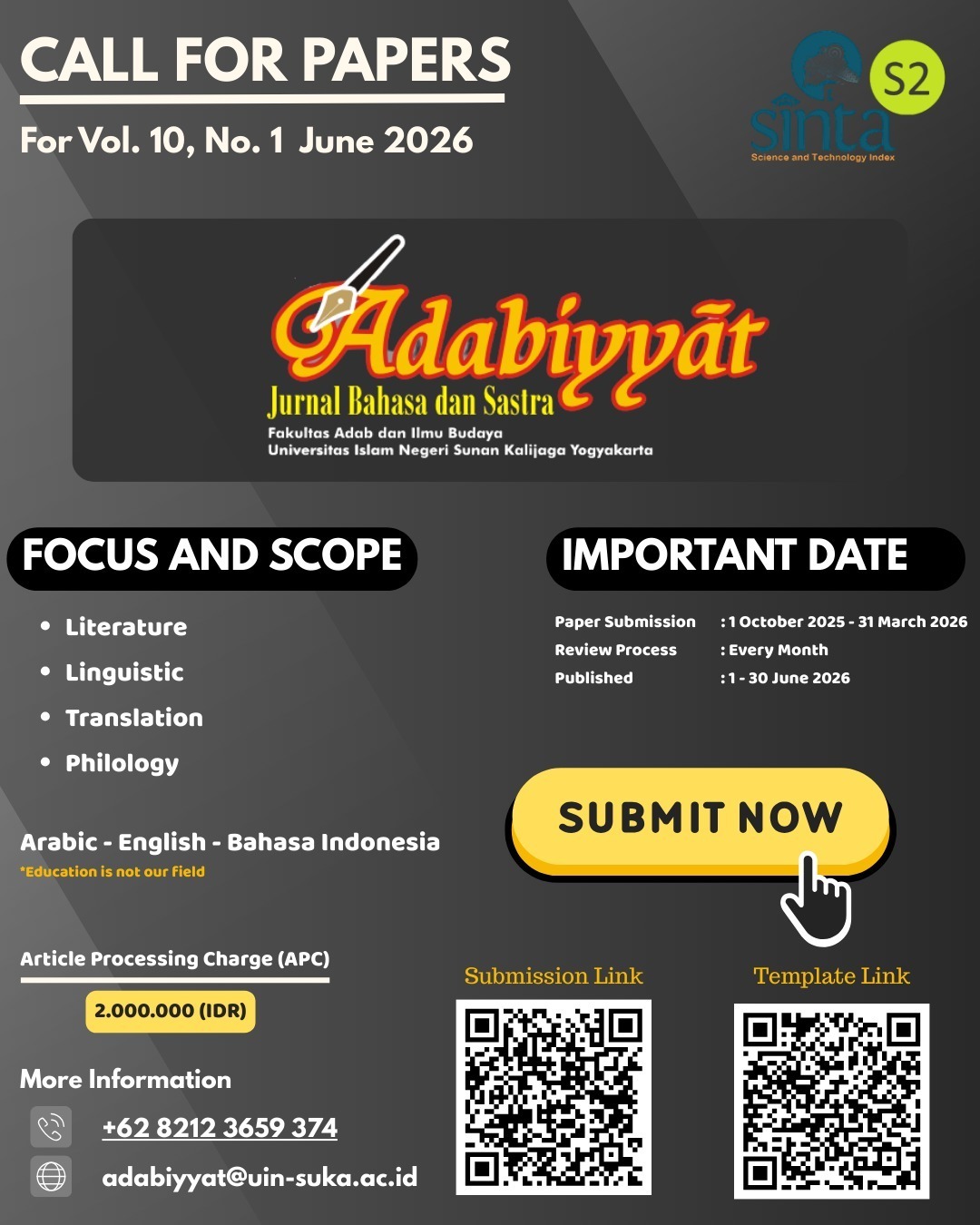SEJARAH BALAGAH: ANTARA MA’RIFAH DAN SINĀ’AH
DOI:
https://doi.org/10.14421/ajbs.2011.10102Abstract
When the literary world enters the realm of scientific study, the arbitrariness and the infinity of expression, which is the main characteristic of literary work, should be evaluated based on an objective standard of science. Balagah, a literary theory born and developed in Arab, has also undergone a process of standardization of concepts and theories as other sciences. This paper describes the history of balagah from embryonic phase until it has been structured to be a science with a set of scientific theories. A historical approach is expected to be able to reveal historical facts related to the codification of balagah since the beginning of its existence until its latest development. The systematization and theorization of balagah had been done since there was a trend of translations of Greek philosophy into Arabic. The demand of scientific knowledge in Greek tradition greatly endorsed the theorizing of balagah. Standardization of the theory of balagah positively facilitates learners to understand the science of balagah and to have scientific accountability. However, the systematization of balagah has led this study to a static condition. In addition, the orientation of balagah is more in linguistic (syntax) area.Simak
Downloads
References
Abbas, Fadl Hasan. 2000. Al-Balagah Funūnuhā wa Afnānuhā: Ilmu al-Ma’ani. Yordania: Dar al-Furqan.
Abdullah, Rajā. T.t. Falsafah Balāgah: Baina al-Taqniyyah wa al-Tatawwur. Iskandaria: Nasy'ah al-Ma‘ārif. Cet ke-2.
Abu Satīt, Syahāt Muhammad Abdul Rahmān. 1988 M/1408 H. Al-Bahsu al-Balāgī fi Z|ilāli al-Qur'ān al-Karīm. Cet. ke-1. Mesir: Matba'ah Amānah.
Al-Hāsyimi, Ahmad. 1994 M/1414H. Jawāhir al-Balagah. Beirut: Dār al-Fikri.
Al-Jābiri, Muhammad ‘Abid. 2000. Bunyah al-‘Aql al-‘Arabī. Cet. ke-7. Beirut: Dār al-Bayda'.
Al-Rāzi, Fakhruddin. 1989. Nihayat al-Ījaz fi Dirāyat al-I‘jaz. Cet. ke-1. Kairo: al-Maktab al-Tsaqafi.
Daif, Syauqi. 1965. Al-Balagah: Tatawwur wa Tārīkh. Cet. ke-4 Kairo: Dār al-Ma‘ārif.
Hasan, Tamam. 2000. Al-Usūl. Kairo: 'Alam al-Kutub.
Husain, Abdul Qadir. 1986. Asar al-Nuhāt fi al-Bahsi al-Balāgi. Cet. ke-2. Qatar: Dār al-Qathri Ibn al-Faj'āt.
Ibn Abdillah, Abi Abdillah Yāqut. 1991. Mu’jam al-Udabā‘: Irsyad al-Arīb ila Ma’rifat al-Adīb. Cet. ke-1, jld. IV. Beirut: Dār al-Kutub al-‘Ilmiyah.
Ibrahim, Tahā Ahmad. 1937. Tārikh al-Naqd al-Adabi ‘inda al-Arab. Beirut: Dār al-Kutub al-‘Ilmiyyah.
Iskandari, Ahmad dan Mustafa 'Annani. 1916. Al-Wasit. Mesir: Dār al-Ma'ārif.
Manzūr, Muhammad. 1948. Al-Naqd al-Manhajiy ‘inda al-‘Arab. Kairo: Maktabah Nahdhah al-Mishriyyah.
Nurgiantoro, Burhan. 2002. Teori Pengkajian Fiksi. Cet. ke-4. Yogyakarta: Gadjah Mada University Press.
Sakkāki, Yūsuf ibn Abi Bakar Ya'kub ibn 'Ali. 1987. Miftāhul 'Ulūm. Cet. ke-2. Beirut : Dār al-Kutub al-'Ilmiyyah.
Sudjiman, Panuti dan Aart Van Zoest, et. al. 1992. Serba-serbi Semiotika. Jakarta: Gramedia Pustaka.
Syāyib, Ahmad. 1964. Ushūl al-Naqd al-Adaby. Cet. ke-7. Kairo: Maktabah al-Nahdah al-Misriyyah.
Verhaar, J.W.M. 2001. Asas-asas Linguistik Umum. Cet. III. Yogyakarta: Gadjah Mada University Press.
Downloads
Published
Issue
Section
License
- Adabiyyāt: Jurnal Bahasa dan Sastra publishes all articles entirely in full text.
- It is permissible for readers to download and to use it for scientific purposes and scientific dissemination.
- The author can re-publish the article that has been published by the Adabiyyāt: Jurnal Bahasa dan Sastra after obtaining written permission from the editor. This letter can be obtained by submitting a request letter for permission to republish the article to Adabiyyāt: Jurnal Bahasa dan Sastra via email adabiyyat@uin-suka.ac.id. In the second publication, the author is required to include information that the article was firstly published by the Adabiyyāt: Jurnal Bahasa dan Sastra.









